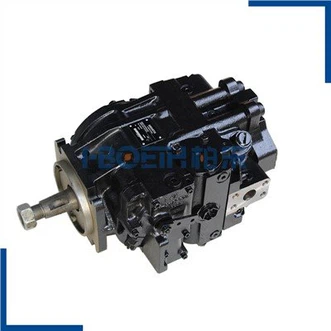Displacement and flow
(1) Displacement v The volume of liquid discharged calculated by the change of the geometric size of the sealing cavity is calculated by the transmission spindle of the displacement v hydraulic pump per revolution (or one arc), which is called the displacement of the hydraulic pump, that is, the volume of liquid that can be discharged by one revolution of the pump shaft without leakage. The legal unit of measurement for displacement is m3/r (cubic meters per revolution), and the commonly used unit in engineering practice is mL/r (milliliters per revolution) (1mL/r=lOOOmm3/r, 1m3/r=106 mL/r).
(2) The volume of liquid discharged by the theoretical flow QT hydraulic pump calculated by the change of the geometric size of its sealing cavity in unit time, that is, the volume of liquid that can be discharged per unit time without leakage, is called the theoretical flow rate of the hydraulic pump, which generally refers to the average theoretical flow rate regardless of the pulsation of the liquid output by the hydraulic pump. In engineering practice, the flow rate of the pump under zero differential pressure is often regarded as the theoretical flow.
The legal unit of measurement for flow rates (theoretical, instantaneous, average, actual, leakage, etc.) is m3/s (cubic meters per second). The commonly used unit in engineering practice is L/min (liters per minute) (1L/min = 106 mm3/min, 1m3/s = 60000L/min).
The relationship between the theoretical flow rate qt of the hydraulic pump and the displacement V of the pump is as follows:
qt=(Vn/60)×l0-6 (m3/s) (1-1)
Formula V - displacement of hydraulic pump, mL/r;
n - the speed of the hydraulic pump, r/min.
(3) The instantaneous flow of the QINST pump at each instantaneous flow is called the instantaneous flow of the hydraulic pump, which generally refers to the instantaneous theoretical (geometric) flow, which has a certain pulsation.
(4) Average flow QAV The flow rate calculated according to the average time is called the average flow rate of the hydraulic pump.
(5) When the rated flow QN hydraulic pump operates under the rated pressure and rated speed, the output flow that the hydraulic pump must ensure according to the test standards.
(6) Actual flow q The actual discharge flow of the hydraulic pump when it is working is called the actual flow of the hydraulic pump.
Due to the leakage of the hydraulic pump and the loss of part of the flow due to the compression of the liquid, the rated flow QN and the actual flow Q of the hydraulic pump are smaller than the theoretical flow QT of the pump.
The actual traffic q can be expressed as
q=qt-q1=Vn-k1△p (1-2)
Q1 - the flow rate lost by the hydraulic pump to the outside or the low pressure chamber due to leakage and compression;
K1 – leakage coefficient of the pump;
△P - the pressure difference of the pump, when the inlet (gauge pressure or relative pressure) pressure of the pump is approximately zero, the outlet working pressure P of the pump can be used instead, the same below.
The other symbols have the same meaning.
From equations (1-2), it can be seen that Q1 and Q are related to the working pressure p of the pump, and when the working pressure increases, the loss flow Q1 increases, while the actual output flow Q decreases.







